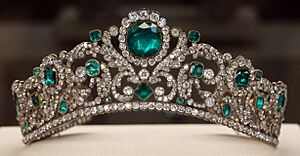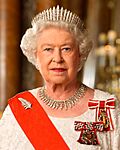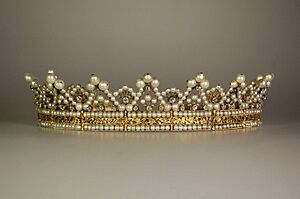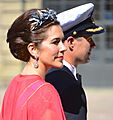Tiara facts for kids
A tiara is a special kind of jeweled head decoration. It's like a fancy crown that women wear for important events. The idea of wearing these sparkling headpieces started a long, long time ago in ancient Iran. Later, people in ancient Greece and Rome also began to wear them.
In Europe, tiaras became very popular in the late 1700s. They were seen as a fancy piece of jewelry for women to wear at formal parties and gatherings. Most modern tiaras are shaped like a half-circle. They are usually made from silver, gold, or platinum and are covered with precious stones, pearls, or cameos (carved gems).
Tiaras were super popular in the late 1800s, especially at events where people wore very formal clothes, called "white tie". After World War I, wearing tiaras became less common, except for special royal events. But since the early 2000s, people have become interested in tiaras again! Sometimes, the word "tiara" is used to mean the same thing as "diadem".
Contents
What is a Tiara?
The main shape of a modern tiara is a half-circle. They are usually made from fancy metals like silver, gold, or platinum. But some tiaras have also been made from interesting materials like tortoiseshell, coral, and quartz. In the 1900s, people even tried making them from horn and aluminum!
Tiaras are often covered with beautiful jewels, pearls, or cameos. These decorations are usually arranged in balanced patterns. You might see shapes like arches, garlands (like wreaths), circles, stars, or fancy flowers and leaves. Sometimes, flowers, ears of corn, dragonflies, or butterflies are shown very realistically, using different colored gemstones. A single tiara can have hundreds or even thousands of gems of all sizes. Almost all tiaras have lots of diamonds. This makes tiaras some of the most expensive and amazing pieces of jewelry.
Tiaras come in different styles, including:
- The bandeau: This tiara looks like a ribbon or a hairband.
- The kokoshnik: This style often looks like a solid wall of gemstones. Its shape comes from a traditional Russian headdress.
- The circlet: This tiara goes all the way around the head.
- The fringe: This tiara has a fringed design made of diamonds. It can often be worn as a necklace too!
Tiaras are worn on top of the head, or sometimes around the forehead. It depends on the tiara's style and what was fashionable at the time. Wearing a large tiara can sometimes cause headaches. To make them more comfortable, big tiaras are often attached to a special frame. This frame is cushioned with soft velvet ribbons.
Some tiaras can be taken apart. Their pieces can then be worn separately as a necklace or a brooch (a decorative pin). Tiaras are sometimes part of a parure. A parure is a matching set of jewelry, like a tiara, necklace, earrings, brooches, and bracelets.
Tiara Rules
Some people think that only women with royal titles can wear a tiara, but that's not true! Any woman can wear a tiara to events where the dress code is "white tie". This means very formal evening wear. However, this rule usually doesn't apply to events held in hotels.
Traditionally, young women didn't wear a tiara until they were married. On their wedding day, they would wear a tiara that belonged to their own family. After they got married, they were supposed to only wear tiaras that belonged to their husband's family, or ones they owned themselves. The only exception was for unmarried princesses, who were allowed to wear tiaras from the age of eighteen. Today, these rules are not followed as strictly.
There are even special black tiaras! They are made from materials like jet, onyx, glass, or steel. These were worn with mourning clothes (clothes worn when someone has died). For later stages of mourning, tiaras with purple stones (amethyst), white stones (diamonds and moonstone), or pearls were also considered proper.
Tiara History
Early History
The words "tiara" and "diadem" both come from ancient head ornaments. These were worn by both men and women to show they were important. The word "tiara" actually comes from Persia. It first described the tall, pointed hats worn by Persian kings, which had "diadems" (decorative bands) wrapped around them. Now, "tiara" is used for almost any fancy head decoration.
Ancient Greeks and Romans made wreath-shaped head ornaments out of gold. The Scythians (an ancient group of people) wore headpieces that looked like a stiff halo. This style later inspired the Russian kokoshnik tiaras. After the Roman Empire fell and Christianity grew, the use of tiaras and diadems became less common.
From the early Middle Ages, European princesses and queens wore crowns. Brides also wore special bridal crowns on their wedding day. In the 1600s and 1700s, queens started wearing head ornaments to show their special status. But this trend didn't become very popular. One reason was that the huge hairstyles women wore in the 1700s made it hard to wear a tiara.
18th and 19th Century Popularity
In the late 1700s, a new art style called Neoclassicism brought tiaras back into fashion. But this time, they were only for women. Jewelers looked to ancient Greece and Rome for ideas and created new wreath-like tiaras from precious gems.
Napoleon and his wife, Joséphine de Beauharnais, helped make tiaras very popular again. This was part of the new Empire style of fashion. Napoleon wanted the French court to be the most magnificent in Europe. He gave his wife many matching jewelry sets (parures) that included tiaras. Some tiaras made for Joséphine are still owned by European royal families today, like the Swedish cameo tiara.
In the 1800s, tiaras quickly became popular among royal and noble women. They were a way to show off their status and get attention. Tiaras became a must-have for women's outfits at court events, balls, dinners, and other fancy parties. Often, a bride would receive a tiara as a gift from her husband or father on her wedding day.
Tiaras were most popular between 1890 and 1914. Women from the richest families often had several tiaras to choose from. Wearing a tiara was no longer just for noble families. In the United States, tiaras were also common at fancy events, especially among the wealthy in New York. Famous jewelry companies like Garrard, Fabergé, Chaumet, Cartier, and Van Cleef & Arpels all made tiaras for their rich customers.
Wealthy American women wanted to be as grand as the old European noble families. They bought fancy country houses from Europe and filled them with old family portraits and furniture. They also ordered tiaras from famous jewelers like Cartier.
20th and 21st Century Tiaras
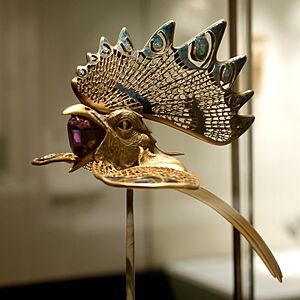
When new art styles like Jugendstil and Art Nouveau appeared, the difference between jewelry and art became less clear. Artists like René Lalique created artistic tiaras that were sometimes hard to wear in real life.
After World War I, wearing a tiara became less fashionable. This was partly because of social and economic changes. Showing off a lot of wealth was seen as less acceptable. Also, women started cutting their hair short and washing it more often. Clean, soft hair doesn't hold a tiara as well.
During the Art Deco period (between World War I and World War II), tiaras were made with straight, geometric patterns. These were also designed to be easy to wear with short hair. In the 1960s, tiaras briefly came back when the tall beehive hairstyle became popular.
Since the late 1900s, tiaras are mostly worn only at very formal events like state dinners, royal weddings, and coronations (when a new king or queen is crowned). At most "white-tie" events today, a tiara is no longer required. However, new tiaras are still being made. Some auction houses and jewelers have seen more interest in tiaras since the early 2000s. The famous fashion designer Versace even made a tiara that was worn by pop star Madonna. The Danish royal family has a tiara that was designed in 2009 for a special exhibit of old and new tiaras.
Famous Tiara Collections
Queen Elizabeth II was said to have the largest and most valuable collection of tiaras in the world. Many of these were family treasures of the British royal family. She often wore them at official events. The Queen inherited many tiaras, especially from Queen Alexandra and Queen Victoria. Queen Mary bought the Grand Duchess Vladimir tiara in the 1920s. It has many interlocking diamond circles. You can attach pearl drops or emeralds inside these circles. Queen Mary also had a special tiara made for the Delhi Durbar in India in 1911. This tiara is now worn by Queen Camilla, the wife of King Charles III. Queen Elizabeth II also had a new ruby and diamond tiara made. She received aquamarines as a gift from the people of Brazil, and these were added to diamonds to make another new tiara.
Other queens, empresses, and princesses regularly wear tiaras at formal evening events. The Swedish Royal Family has a collection, as do the Danish, the Dutch, and Spanish royal families. Many of the Danish royal jewels came into their collection when Princess Louise of Sweden married the future King Frederik VIII of Denmark. The Romanov dynasty in Russia had a huge collection until the Russian Revolution in 1917. The Iranian royal family also had many tiaras. Since the Iranian Revolution, these are kept at the National Jewelry Museum in Tehran.
Sometimes, if a tiara is very old and valuable because of its history or rare gems, realistic copies might be made. These copies are then worn instead of the original, often for safety or insurance reasons.
-
The beautiful tiara of Empress Farah Pahlavi of Persia (Iran).
-
The 'midnight tiara' was made in 2009. Crown Princess Mary of Denmark is wearing it.
-
The Cameo tiara was originally made for Josephine de Beauharnais. It is now owned by the Swedish royal family and worn by Crown Princess Victoria.
See also
- Aigrette
- Circlet
- Civic crown
- Coronet
- Crown
- Diadem
- Headband
- Laurel wreath
- Liangbatou
- Military tiara
- Mural crown
- Papal tiara
- Jewels of Elizabeth II
- Jewels of Diana, Princess of Wales
- Jewels of the Swedish royal family
- Tainia


